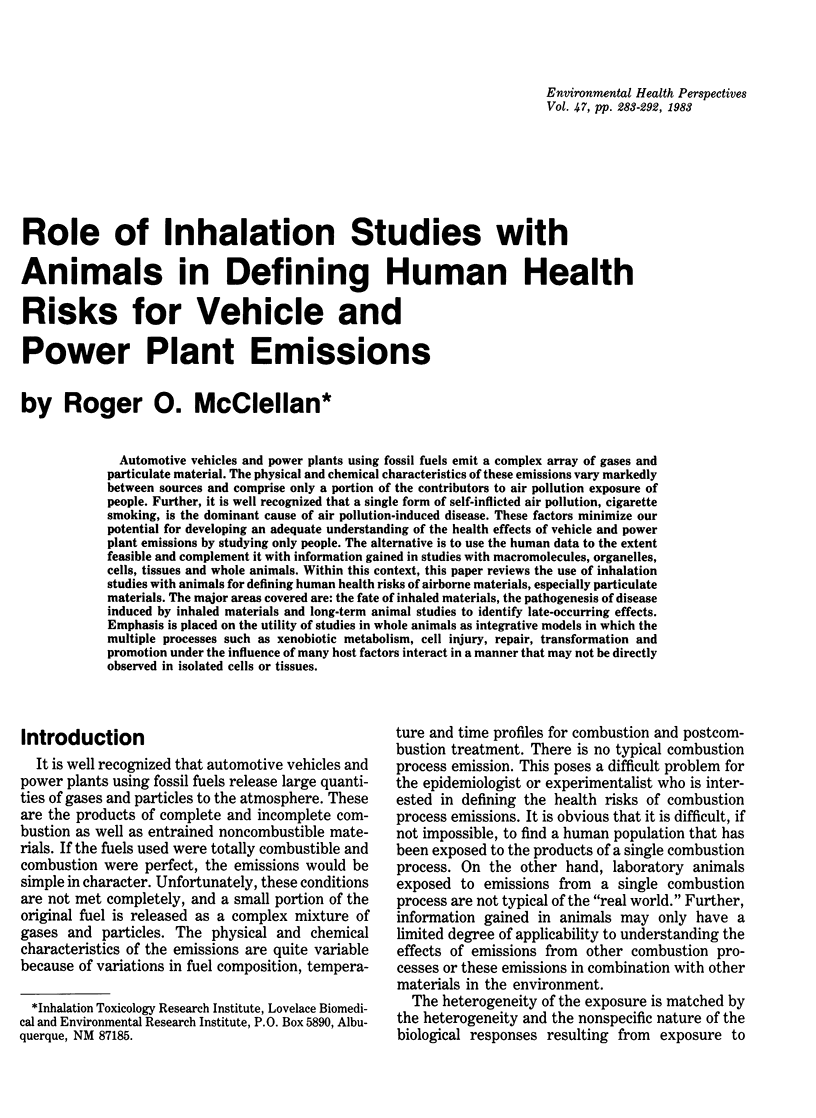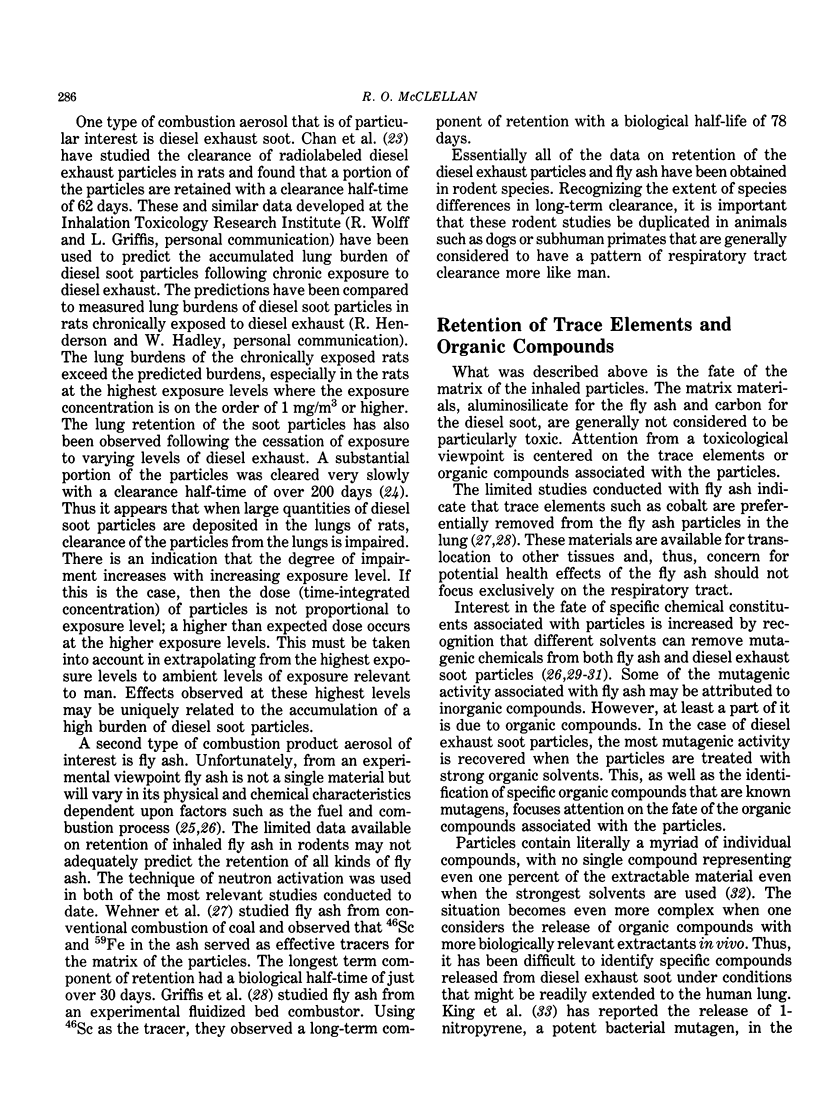Abstract
Automotive vehicles and power plants using fossil fuels emit a complex array of gases and particulate material. The physical and chemical characteristics of these emissions vary markedly between sources and comprise only a portion of the contributors to air pollution exposure of people. Further, it is well recognized that a single form of self-inflicted air pollution, cigarette smoking, is the dominant cause of air pollution-induced disease. These factors minimize our potential for developing an adequate understanding of the health effects of vehicle and power plant emissions by studying only people. The alternative is to use the human data to the extent feasible and complement it with information gained in studies with macromolecules, organelles, cells, tissues and whole animals. Within this context, this paper reviews the use of inhalation studies with animals for defining human health risks of airborne materials, especially particulate materials. The major areas covered are: the fate of inhaled materials, the pathogenesis of disease induced by inhaled materials and long-term animal studies to identify late-occurring effects. Emphasis is placed on the utility of studies in whole animals as integrative models in which the multiple processes such as xenobiotic metabolism, cell injury, repair, transformation and promotion under the influence of many host factors interact in a manner that may not be directly observed in isolated cells or tissues.
Full text
PDF









Selected References
These references are in PubMed. This may not be the complete list of references from this article.
- Ames B. N. Identifying environmental chemicals causing mutations and cancer. Science. 1979 May 11;204(4393):587–593. doi: 10.1126/science.373122. [DOI] [PubMed] [Google Scholar]
- Ames B. N., Mccann J., Yamasaki E. Methods for detecting carcinogens and mutagens with the Salmonella/mammalian-microsome mutagenicity test. Mutat Res. 1975 Dec;31(6):347–364. doi: 10.1016/0165-1161(75)90046-1. [DOI] [PubMed] [Google Scholar]
- Autrup H., Harris C. C., Stoner G. D., Selkirk J. K., Schafer P. W., Trump B. F. Metabolism of [3H]benzo[a]pyrene by cultured human bronchus and cultured human pulmonary alveolar macrophages. Lab Invest. 1978 Mar;38(3):217–224. [PubMed] [Google Scholar]
- Binns R. Animal inhalation studies with tobacco smoke. Rev Environ Health. 1975;2(2):81–116. [PubMed] [Google Scholar]
- Brain J. D., Knudson D. E., Sorokin S. P., Davis M. A. Pulmonary distribution of particles given by intratracheal instillation or by aerosol inhalation. Environ Res. 1976 Feb;11(1):13–33. doi: 10.1016/0013-9351(76)90107-9. [DOI] [PubMed] [Google Scholar]
- Chan T. L., Lee P. S., Hering W. E. Deposition and clearance of inhaled diesel exhaust particles in the respiratory tract of Fischer rats. J Appl Toxicol. 1981 Apr;1(2):77–82. doi: 10.1002/jat.2550010206. [DOI] [PubMed] [Google Scholar]
- Chan T. L., Lippmann M. Experimental measurements and empirical modelling of the regional deposition of inhaled particles in humans. Am Ind Hyg Assoc J. 1980 Jun;41(6):399–409. doi: 10.1080/15298668091424942. [DOI] [PubMed] [Google Scholar]
- Clark C. R., Hobbs C. H. Mutagenicity of effluents from an experimental fluidized bed coal combustor. Environ Mutagen. 1980;2(2):101–109. doi: 10.1002/em.2860020202. [DOI] [PubMed] [Google Scholar]
- Cohen G. M., Marchok A. C., Nettesheim P., Steele V. E., Nelson F., Huang S., Selkirk J. K. Comparative metabolism of benzo(a)pyrene in organ and cell cultures derived from rat tracheas. Cancer Res. 1979 Jun;39(6 Pt 1):1980–1984. [PubMed] [Google Scholar]
- Dahl A. R., Hadley W. M., Hahn F. F., Benson J. M., McClellan R. O. Cytochrome P-450-dependent monooxygenases in olfactory epithelium of dogs: possible role in tumorigenicity. Science. 1982 Apr 2;216(4541):57–59. doi: 10.1126/science.7063870. [DOI] [PubMed] [Google Scholar]
- Dalbey W. E., Nettesheim P., Griesemer R., Caton J. E., Guerin M. R. Chronic inhalation of cigarette smoke by F344 rats. J Natl Cancer Inst. 1980 Feb;64(2):383–390. doi: 10.1093/jnci/64.2.383. [DOI] [PubMed] [Google Scholar]
- Doll R., Peto R. The causes of cancer: quantitative estimates of avoidable risks of cancer in the United States today. J Natl Cancer Inst. 1981 Jun;66(6):1191–1308. [PubMed] [Google Scholar]
- Dontenwill W., Chevalier H. J., Harke H. P., Lafrenz U., Reckzeh G., Schneider B. Investigations on the effects of chronic cigarette-smoke inhalation in Syrian golden hamsters. J Natl Cancer Inst. 1973 Dec;51(6):1781–1832. doi: 10.1093/jnci/51.6.1781. [DOI] [PubMed] [Google Scholar]
- Feldman G., Remsen J., Wang T. V., Cerutti P. Formation and excision of covalent deoxyribonucleic acid adducts of benzo[a]pyrene 4,5-epoxide and benzo[a]pyrenediol epoxide I in human lung cells A549. Biochemistry. 1980 Mar 18;19(6):1095–1101. doi: 10.1021/bi00547a008. [DOI] [PubMed] [Google Scholar]
- Fisher G. L. Biomedically relevant chemical and physical properties of coal combustion products. Environ Health Perspect. 1983 Jan;47:189–199. doi: 10.1289/ehp.8347189. [DOI] [PMC free article] [PubMed] [Google Scholar]
- Friberg L., Cederlöf R. Late effects of air pollution with special reference to lung cancer. Environ Health Perspect. 1978 Feb;22:45–66. doi: 10.1289/ehp.782245. [DOI] [PMC free article] [PubMed] [Google Scholar]
- Gehring P. J., Watanabe P. G., Park C. N. Resolution of dose-response toxicity data for chemicals requiring metabolic activation: example--vinyl chloride. Toxicol Appl Pharmacol. 1978 Jun;44(3):581–591. doi: 10.1016/0041-008x(78)90266-1. [DOI] [PubMed] [Google Scholar]
- Griffis L. C., Snipes M. B., Brooks A. L. Clearance by the rat of inhaled fly ash from fluidized-bed coal combustion. J Toxicol Environ Health. 1981 Jan;7(1):117–124. doi: 10.1080/15287398109529963. [DOI] [PubMed] [Google Scholar]
- Hadley W. M., Dahl A. R. Cytochrome P-450 dependent monooxygenase activity in rat nasal epithelial membranes. Toxicol Lett. 1982 Mar;10(4):417–422. doi: 10.1016/0378-4274(82)90240-5. [DOI] [PubMed] [Google Scholar]
- Henry M. C., Kaufman D. G. Clearance of benzo(alpha)pyrene from hamster lungs after administration on coated particles. J Natl Cancer Inst. 1973 Dec;51(6):1961–1964. doi: 10.1093/jnci/51.6.1961. [DOI] [PubMed] [Google Scholar]
- Henry M. C., Port C. D., Kaufman D. G. Importance of physical properties of benzo(a)pyrene-ferric oxide mixtures in lung tumor induction. Cancer Res. 1975 Jan;35(1):207–217. [PubMed] [Google Scholar]
- Karagianes M. T., Palmer R. F., Busch R. H. Effects of inhaled diesel emissions and coal dust in rats. Am Ind Hyg Assoc J. 1981 May;42(5):382–391. doi: 10.1080/15298668191419910. [DOI] [PubMed] [Google Scholar]
- Kuschner M. The causes of lung cancer. Am Rev Respir Dis. 1968 Oct;98(4):573–590. doi: 10.1164/arrd.1968.98.4.573. [DOI] [PubMed] [Google Scholar]
- Lewtas J. Evaluation of the mutagenicity and carcinogenicity of motor vehicle emissions in short-term bioassays. Environ Health Perspect. 1983 Jan;47:141–152. doi: 10.1289/ehp.8347141. [DOI] [PMC free article] [PubMed] [Google Scholar]
- Lippmann M., Yeates D. B., Albert R. E. Deposition, retention, and clearance of inhaled particles. Br J Ind Med. 1980 Nov;37(4):337–362. doi: 10.1136/oem.37.4.337. [DOI] [PMC free article] [PubMed] [Google Scholar]
- Pott F., Stöber W. Carcinogenicity of airborne combustion products observed in subcutaneous tissue and lungs of laboratory rodents. Environ Health Perspect. 1983 Jan;47:293–303. doi: 10.1289/ehp.8347293. [DOI] [PMC free article] [PubMed] [Google Scholar]
- Saffiotti U., Cefis F., Kolb L. H. A method for the experimental induction of bronchogenic carcinoma. Cancer Res. 1968 Jan;28(1):104–124. [PubMed] [Google Scholar]
- Saffiotti U. Evaluation of mixed exposure to carcinogens and correlations of in vivo and in vitro systems. Environ Health Perspect. 1983 Jan;47:319–324. doi: 10.1289/ehp.8347319. [DOI] [PMC free article] [PubMed] [Google Scholar]
- Schuetzle D. Sampling of vehicle emissions for chemical analysis and biological testing. Environ Health Perspect. 1983 Jan;47:65–80. doi: 10.1289/ehp.834765. [DOI] [PMC free article] [PubMed] [Google Scholar]
- Teel R. W. Induction of aryl hydrocarbon hydroxylase in primary cultures of type II alveolar lung cells and binding of metabolically activated benzo[a]pyrene to nuclear macromolecules. Cancer Lett. 1979 Oct;7(6):349–355. doi: 10.1016/s0304-3835(79)80065-8. [DOI] [PubMed] [Google Scholar]
- Thyssen J., Althoff J., Kimmerle G., Mohr U. Inhalation studies with benzo[a]pyrene in Syrian golden hamsters. J Natl Cancer Inst. 1981 Mar;66(3):575–577. [PubMed] [Google Scholar]
- Vostal J. J. Bioavailability and biotransformation of the mutagenic component of particulate emissions present in motor exhaust samples. Environ Health Perspect. 1983 Jan;47:269–281. doi: 10.1289/ehp.8347269. [DOI] [PMC free article] [PubMed] [Google Scholar]
- Waligora S. J., Jr Pulmonary retention of zirconium oxide ( 95 Nb) in man and beagle dogs. Health Phys. 1971 Jan;20(1):89–91. [PubMed] [Google Scholar]
- Wehner A. P., Wilkerson C. L., Mahaffey J. A., Milliman E. M. Fate of inhaled fly ash in hamsters. Environ Res. 1980 Aug;22(2):485–498. doi: 10.1016/0013-9351(80)90160-7. [DOI] [PubMed] [Google Scholar]


